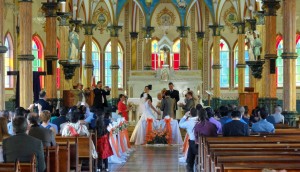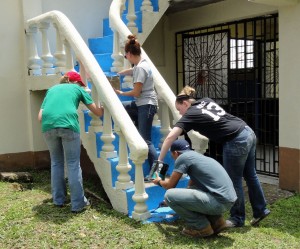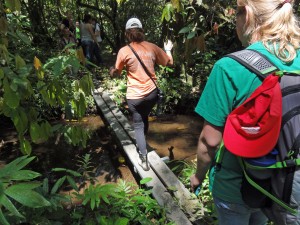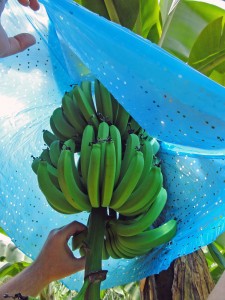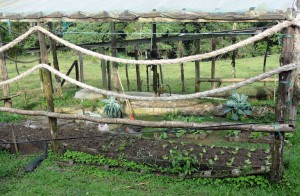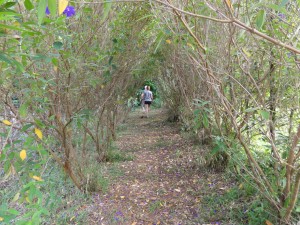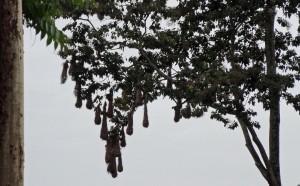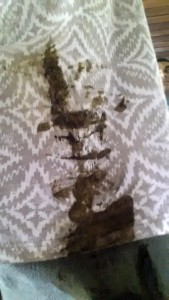Today is the flight home. I’m both sorry and glad. It was a fantastic trip and an experience that I’ll remember for a very long time. It was also a great length for a trip like this. We packed in a lot over a short period of time, yet we also had some down time. At times there was a lot of rushing and at times a lot of waiting. Each thing we did was great, and the trip was well worth the cost. I definitely want to do another study abroad. I was able to keep up with everyone despite packing too much. Next time I will have a better idea of what to bring and what to leave at home, though I certainly did better than I would have without a packing list. If possible during the four years I’ll be getting this degree, I’d like to go abroad three times, possibly to Iceland or Australia. At first it was a little awkward being among so many undergrads with such a large age difference, but the students on this trip were pretty mature, and the awkwardness fell away. Future trips will probably be in graduate programs, so there will be less of an age difference, but it will still be there. Regardless, traveling abroad is so important that I want to go to as many different places as possible. Plus it’s so rewarding and fun. Thanks to the study abroad team for putting together an awesome spring break experience!
Costa Rica
Items related to study abroad service learning trip to Costa Rica during spring break 2015
Costa Rica – Day 8 – Mountain towns

Panorama view from the mountaintop restaurant where we ate lunch overlooking the Central Valley. Click to enlarge.
Today was spent driving through the mountains and seeing a couple of small communities on the way to the airport hotel. We really gave the gears of the van a good workout. The road was windy, with traffic coming to a full stop several times, including one long stop due to a traffic accident. But the air was cool enough to turn off the van’s AC and open the windows. This was maybe the first day in Costa Rica when I wasn’t covered in sweat from the moment of walking out the door – even at midday I was pretty comfortable.
The view was gorgeous the entire trip. We saw several hills covered with coffee plants or terraced with cabbage. We also passed lots of trucks loaded with sugar cane, as well as a former sugar cane factory that is now a milk factory. This made me wonder if they pasteurize the milk in Costa Rica. Obviously they didn’t at Laureles Farm – they drink it straight from the cow. But probably the milk sold in stores is pasteurized. It also makes me wonder if Costa Rica has large dairy farms with industrial practices as in the U.S. or if most of the milk is sold to the factory from small or organic farms. In fact this whole trip has made me wonder how the representative the animal welfare practices I saw at Earth and the home stay farms are of the rest of the country. Our guide Mario discussed this a lot when it came to organic vs nonorganic crops such as bananas but we didn’t really touch on this regarding animal husbandry or welfare practices. It’s also telling that the students on the trip had never seen the word husbandry applied to animal care because in the U.S. it’s all about animal science.
While we were driving through the mountains, the resident director Paul told us that back in the 70s, McDonald’s had deforested thousands and thousands of hectares in the area to create room for beef cattle to graze. This is an area where trees grow very slowly, and it has still not recovered. We did see lots of small groups of cattle grazing – some of them balanced in very precarious spots on the side of mountains. It made me wonder if many of the lose their footing and go tumbling down. They are such large animals with such small legs to support their weight, and clearly were not designed to graze on the sides of mountains the way, say, mountain goats are. I also tried to imagine what the area must have looked like covered in virgin forest. Some of it probably would have been cut down to make way for towns and such, but not nearly as much as to graze cattle. This damage to the mountain forests in Costa Rica a generation ago may be part of why the country has such a strong environmental mindset now.
Deforestation and other land use changes are a major contributor to climate change – not as much as fossil fuels but definitely a major factor that also needs to be addressed. I feel like industrial farming as it has been practiced in my lifetime has been part of the problem, but farming could also be part of the solution if it is done with an eye toward keeping carbon in the ground. The kinds of farming practices we are seeing in Costa Rica definitely help contribute to the solution. I feel like research in this area is just beginning, but it can’t be done fast enough.

View from the mountains. Note the terraced agriculture and full sugar cane truck in the road below us. Click to enlarge.
The earth evolved with certain areas to be used in certain ways – whether grazing millions of hooved animals such as in the great plains of North America or boasting loads of biodiversity in jungles and forest as in Costa Rica. If humans are to become caretakers of the earth and not destroyers, we will have to learn to live in harmony with what the earth itself has evolved to do, even if it is somewhat turned toward our own purposes. That means while we might be grazing cattle in Nebraska where millions of wild bison used to roam, we need to keep forest to act as the lungs of the planet and host the biodiversity that strengthens the web of life — and not coincidentally provides many of our healing products. What is good for the planet is in the end good for us, and vice versa. We can either accept this and live within the planetary boundaries, or we can go extinct and take a bunch of other life forms with us.
Unfortunately after McDonalds and the other large corporations were done with Costa Rica, they moved on deforesting the Amazon rainforest in Brazil. For many years the problem has been acute, with many football fields of forest disappearing daily. After 2004 rate of deforestation had been declining, but recently it has gone back up. It can be dangerous for environmental activists to try to stop this. A nun from Dayton named Dorothy Stang was murdered in 2005 for just this kind of work in Brazil because there is a lot of money to be made in selling off the rainforest for cattle ranches. Hundreds of environmental activists are killed each year in various places around the world. We must find a way to make preserving the planet as it was meant to be more profitable than liquidating it like a going out of business sale.
The two communities we saw were very relaxing. At Zarcero we stumbled on a wedding in progress at the town church which was really neat. The gardens at that church are famous and tended to by hand by a longtime volunteer. In exploring the town I wandered into what looked like a small business version on PetSmart or Tractor Supply – the store was full of animal feed, boots, bird houses, medicines, saddle gear, and pretty much any animal paraphernalia you might need. In Sarchi we took a group picture at the largest ox cart in the world, which took four years to build, then visited shops owned by the guy who made the cart. We saw where the workers hand paint the wood items sold in the store. I got a great inchworm puzzle with the alphabet on it for my nephew in Scotland, and a 3D cat puzzle and CD of Costa Rican music for my husband.
Costa Rica – Day 7 – End of home stay, ecolodge, hot springs

Our group with the Laureles farm family. From left to right: Becca, Leesha, Fernando, Lidia, Carla, me, and the Laureles grandson in sunglasses in front.
My preparations the night before paid off, as I slept really soundly and not worrying about bugs. The whole thing with the dogs must have bothered me more than I thought because I dreamed that I was walking by a busy street in back of the UNC campus (where I did my undergrad) and found two dogs in different places who had been hit by cars and were lying by the road with broken legs. In the dream I scooped them up and was taking them to get medical care when I woke up.
I got up before dawn, and three of us (Carla, Leesha, and me) went to watch the sun rise over the farm. Just as at the beach at Tortuguero, the sun didn’t come up in a ball like we are used to seeing at home. It just got light. Fernando’s cattle were mostly sitting down (which cattle here seem to do a lot) or grazing peacefully. Leesha tried to make friends with one of their horses in the pasture, but he was shy and didn’t want to get too close. On the way back we stopped by the howler monkey trees again. The monkeys had been very active just before dawn howling to greet it. They were still active getting their breakfast when we stopped by the trees. We probably watched them for a half hour. At first they hid, but after a bit a few came out where we could see them, including a mom with a baby on her back. She sat watching us for a long time, and I got a ton of pics.
Then we went back to the farm where we got to help Fernando milk the cow. That was fun – Leesha was a natural, and I got the hang of it but am glad I don’t have to do it every morning. Fernando put the calf into a separate enclosure while we got a bucket full of milk. When we were done, he let out the calf, who made a beeline for his mom. I’m glad they let the calf stay with the mom. The mother-offspring bond is the strongest in nature, and to talk the calf away so that we can take the milk does not seem right. It was enough to make me switch mainly to almond milk, though it’s hard to avoid dairy entirely. While we were milking the cow with Fernando, Lidia came out with a glass that we filled up straight from the cow. She then used that to make some of the very best pancakes I have ever eaten, which we had along with eggs, juice, and of course rice and beans.
<Optional thoughts about the book I was reading>
While the rest of the group walked for a swim at a river spot with difficult access, I got some reading done in This Changes Everything. Naomi Klein makes the case that climate change will require us to abandon unregulated free market capitalism to enact the collective solutions needed to address carbon emissions. She thinks it is a great opportunity to reshape human relations to be more just, equitable and fair, to enact protections for workers and poor people around the world.
It’s a compelling argument, but I’ve also read some interesting critiques. Basically the critiques say Klein was anti-capitalism before she started writing about climate change – she wrote about clothing factory workers in South America and about disaster opportunism, in which big companies use the opportunity of a disaster to make a windfall profit. The critiques think her current book is more of the same vein, and that she doesn’t give enough credit to some of the market solutions being proposed such as a price on carbon.
Klein says we need a mass social movement to force governments to take the steps needed to address climate change. I agree with that, but I think we need market solutions too. A carbon tax, preferably with the proceeds being returned equitably to everyone in the form of dividend checks or tax cuts as proposed by Citizens Climate Lobby, is a must. Klein thinks this idea is okay but not nearly enough. I think it’s just a start too, but it’s a vital one. We have to disincentivize fossil fuels and incentivize renewables if we want people to make the switch.
Klein seems to talk mostly about mass movements but decentralized control with communities taking charge of their own energy, transit and food systems. I would love to see that, and mass movements are important. That’s what stopped the Keystone pipeline, which is of huge symbolic value, and having participated with the Sierra Club in the People’s Climate March in New York City, I feel like the march helped provide immediacy and momentum to the UN talks that week. It was shortly after that when Obama announced the first-ever agreement with China to lower emissions. Of course none of this is enough and the work is not done, but you have to start somewhere.
This year will be huge for climate agreements leading up to the talks in Paris in December where everyone is hoping for the first time to get a binding agreement across all nations. That will be a tall order. Klein is right that social movements will make a huge difference in the climate debates, and she is right that control needs to come down to the local level.
I’m pleased to live in Columbus, which has a very ambitious green plan. But this leads to my critique of Klein’s focus on social movements. As important as they are, in the end it is governments, whether local state or national, that will decide if, when, and how we address climate change. This is why I’m studying public policy. I’m not exactly sure where this course of study will lead, but climate change is the most important issue not just in my lifetime but maybe in of all human civilization, and I want to be in a place where I can help address it.
<End of thoughts about the book and back to the trip>
So most of Friday afternoon was spent on the bus driving to the Villa Finca Tina ecolodge in the mountains, then to the Baldi hot springs. I’m pretty sure this will get changed up next year, since we didn’t make it to the hot springs until after 9 p.m. so had less than an hour. They were absolutely amazing though, as was the lodge which had several rescued orphan deer and even planted special grasses for the deer to eat.
In Ohio it is against the law to rescue orphan deer. I understand about wildlife rehabilitation needing to be licensed, but we should allow people who care – and most people do – to help animals that need help. Even if those orphans go to a sanctuary to live out their lives, that’s better than being killed just because they were unlucky enough to lose their mother. In one case, a police officer and his wife rescued an orphan deer whose mother had been hit by a car. When the authorities came and take it, the couple claimed the deer had escaped the day before and showed their torn screen door. In reality I’m thinking they probably found a sanctuary out of state to take the deer.
It’s a ways until retirement, but it liked the ecolodge area and hot springs so much, I would give serious consideration to retiring there. The community seemed to have a lot of natural healing practitioners, and as of now it’s affordable. I’ll have to come back with my husband and investigate this idea more thoroughly before making any decisions, but this is now a possibility on the list.
Costa Rica – Day 6 – Service day
Note: Lots of pics from service day are at the bottom of this post.
So I’m not going to lie – last night was a little freaky. We had the light on in our room so we could write in our journals, and it attracted bugs – monster bugs. I don’t freak out easily, but a bug the size of my hand kept flying towards me.
Backing up a bit … I was pretty tired by the time we were done with dinner that I decided to sit on the bed and journal before getting ready for bed. Lidia came in and took down the mosquito netting above the bed and wrapped it all around the bed. I asked if we really needed that, and she said yes. Within 10 minutes I saw why. I could not have been more thankful to have the netting when the monster bugs came in. I finally convinced my roommate that we *had* to turn off the light. The trouble was, I hadn’t gone to the bathroom or changed into my pajamas – but I wasn’t about to leave the protection of the mosquito net with the bugs flying everywhere.
Once we turned off the light, the bugs calmed down, but it was a couple of hours before I got the courage to get up and go to the bathroom and change clothes. Even so I had a hard time sleeping. I tried playing word games on my phone, which is how I get sleepy at home, but the light from the phone got the bugs stirred up again, so that wasn’t going to happen. I may have gotten three hours of sleep if I’m lucky.
I vowed not to make the same mistake again tonight, so as soon as we got back for the evening, I showered, dressed, repacked the suitcase, and put the mosquito netting over everything on my bed and the bed where I was storing my stuff – all while it was still light. I guess everyone who travels to developing countries has a crazy bug story to tell, and now I’ve got mine.
Anyway, today was service day. We painted a church and installed a biodigester on one of the local farms. It was fun and also good to be of use to the people here. The group seems to be gelling pretty well and getting along. One thing I’ve found in life is that the quickest way to really get to know people is to 1) live with them, 2) work with them, or 3) travel with them. People are starting to get more comfortable with each other which is good because it takes less effort to get along. I’ve enjoyed the smaller group at the home stays where we’ve had a chance to talk more with just a few people about matters of substance. Becca was our Spanish speaker in the group and really stepped up. It’s also been nice talking more to Leesha and Carla.
I have really enjoyed seeing the farms, especially how the farmers integrate and use everything. That’s the idea of the biodigester – to put the manure to use in cooking food. Both farms I saw do a great job putting together food scraps for the animals. I did see a few things on both farms that concerned me. Both had dogs tied up by themselves in the back. At one the dog is kept tied up to watch the tilapia pond. The other had two dogs tied up by themselves – one a little cockerpoo that needed a shampoo and trim as bad as any dog I’ve seen.
All these dogs did have dog houses and plenty of food. But dogs are pack animals. They are evolved to be social. It’s really not fair to them to keep them so solitary all the time – if they don’t have a dog pack, then humans are their pack, and they should be kept with us. Of course some people in the U.S. tie up dogs alone, and sometimes forget to feed them, which Mario said happens here too. In some cases at home, the neglect gets so bad that humane agents take the animals – one of my friends runs an agency responsible for this in rural counties outside of Columbus, and the things he sees are terrible.
While the welfare of dogs that I saw at the farms here was certainly better than what my humane agent friend deals with in the U.S., dogs and cats don’t seem to be considered part of the family in Costa Rica. Apparently it’s not part of the culture. I wish it were, but those sorts of norms take a long time to develop and a long time to change. We asked Lidia if they would ever consider bringing their dog in the house, and the answer was a definitive no. She seemed a little surprised when I showed a photo of my cats sitting on the bed with my husband. This is a common occurrence at our house but would never happen here. I don’t think it’s something they can relate to.
Of course as people establish close relationships with their pets, they start thinking about their relationships with other animals. Some people call this anthropomorphism, but I really don’t think it can be dismissed so easily. Animals, especially mammals, have evolved the same structures in their brains as we do to create emotions, and they form the same attachments to people and to each other – as well as the same dislikes, fears, jealousies, etc. Anyone who pays attention to animals can see this. On the other hand, the welfare I saw for farm animals in Costa Rica is much better than for most animals at industrial farms in the United States. So every culture has its pluses and minuses.
Service day photos
Costa Rica – Day 5 – Nature reserve, banana tour, home stays
Note: Many more photos are at the bottom of this post. You can click on any photo to see it larger.
This morning was a hike through a forested nature trail on the grounds of Earth University. One of my goals this trip was to keep up with the undergrads who are half my age, and so far I’m doing okay. Either I’m in better shape than I thought or they are in worse. I felt pretty good this morning and hope that lasts. It helps that in getting a decent amount of exercise this trip. Most of the time at home I’m on the computer for work or school or social media and personal email, which really takes a toll after a few days.
Banana tour
Also this morning was a tour of the banana plantation at Earth University, and of the packing and shipping house where workers sort, clean and box the bananas to go to Whole Foods. Today they were being shipped to the Whole Foods in Jessup, MD. This was so interesting and fulfilling to see. The values of the organization are printed in large letters on the outside of the building. This is a fair trade shop where the workers work an 8 hour shift with lunch and coffee breaks. The work looked very hard even so — I can’t imagine the exploitation that must go on in a shop that isn’t fair trade, which most are not.
The tour made me happy and a little proud that these are the bananas I buy. We first started shopping at Whole Foods because unlike most grocery stores, it has animal welfare standards. I’m willing to pay more for this, and for sustainable standards on seafood and fair trade on products like bananas. Of course this can come at a price. Our guide Mario thought it was pretty funny that the nickname of Whole Foods is “whole paycheck.” I hope someday we can move into a place where I can have a vegetable garden like the one at our home stay location, and we can grow more of our own food. In the meantime, I’d like to start ordering vegetables from a CSA.
Home stays
The home stays will be the true experience of Costa Rica. I’m staying with three other students at a small working farm called Laurel’s with Lidia and Fernando. Besides the garden, they have a horse, several chickens and a very friendly turkey, a pig, about 15 head of beef cattle, a couple of milk cows, and a pond full of fish. We started our tour of the farm by taking turns riding Fernando’s very sweet and well-behaved horse. She was so tolerant of us who haven’t ridden in ages — and who had a little trouble getting on.
Then we walked down the mountainside where Fernando keeps his beef cattle. One of the cows tends to walk and graze with part of his front legs on the ground. Fernando said the cow has a worm, and that he had given the cow a shot. But this made me wonder what kind of veterinary care these animals get. Does someone from Earth University travel to farms to take care of them? Earth has an animal farm because we visited it. I didn’t think to ask there what kind of veterinary care those animals get, but hopefully they have some kind of veterinary program there, even if it is not as developed as the one at Ohio State.
The other notable thing about Lidia and Fernando’s farm is the howler monkeys in the back yard. As we were touring the farm, we heard them hooting to each other a lot, so Fernando walked us over to the trees where they live and threw in a few sticks to get them to come out where we could see them. It worked. We saw four or five on various tree branches howling a lot at us.
I was surprised how small they are based on how loud the sound they make is – so they live up to their name. The males have a special vocal sac in their throat that helps them amplify the sound they make, which sounds like a strong wind running through a tunnel. I did wonder what the monkeys on Fernando’s farm were trying to tell us – was it a greeting or more of a warning to tell us to get out of their territory? I’m guessing the latter – that’s what it sounded like. I hope we didn’t stress them out too much, but living next to a farm, they have to be pretty used to interactions with humans.
Nature reserve photos

Mario tells us how the tree roots buttress out above ground because the tropical soil is so shallow.
Banana tour photos
Home stay photos
Costa Rica – Day 4 – Tortuguero wildlife tour, Guapiles
This morning several of us got up to watch the sun rise over the beach at Tortuguero. Days in Costa Rica are not much longer or shorter than 12 hours because it is so close to the equator. Perhaps because of cloud cover, we also didn’t get the see the sun rise in an orange ball of fire the way it does at home. It just started to get light, and was daylight within about 10 minutes.
Before breakfast we did a wildlife tour by boat through the rivers and canals of Tortuguero. The waterways snake around in all directions. They are called canals, which made me think they were dug out by people, but they are all natural. We saw several monkeys in trees, a sloth at the very top of a huge tree, lots of birds, several iguanas and lizards sunning themselves, and a caiman near a Canadian research station that we happened across.
The highlight was running across a group of capuchin monkeys getting into several buckets of food waste that someone had left out on a dock to be picked up. They were having a field day, having lucked into free food supply. I got 3 minutes of great video of the monkeys getting in and out of the food. Another highlight was boating back into a branch of the river and watching the water turn black from the tannin in the trees. The black water reflected the image of the trees on the shore — even the depth seemed to reflect so that it looked like the trees were growing down into the river.
One of the most interesting and ubiquitous birds we have seen — and heard — is the oropendola. They build nests like I’ve never seen in the U.S. — the nests are in bulbous formations that hang from tree branches. They also sound like nothing I’ve ever heard before. The name “oro” or gold refers to the birds’ yellow plumage, and “pendola” refers to the hanging nests. I won’t forget those birds anytime soon!
Later walking around in the town of Guapiles, our resident director Paul pointed me to passion fruit, which I’ve never had before. It doesn’t look like much on the outside, but the inside is something special. It looks like caviar and tastes sweet but not sugary. Hopefully I can find this fruit at the Whole Foods in Columbus because I can’t bring back the bunch that I bought here, and I definitely want to eat this again.
In the evening it was back to Earth University.
Costa Rica – Day 3 – Beach cleanup at Tortuguero National Park
Today we traveled to Tortuguero National Park in the northeast Caribbean coast of Costa Rica. This is one of the country’s 26 national parks, and the one most known for hosting the hatching grounds for several species of endangered sea turtle (“tortuga” means turtle). It is also known for its network of rivers and canals, accessible only by boat. To get there, we had to travel about 2 hours on back roads to the boat station, then transfer to a boat that took us another hour up a river with all kinds of curves and switchbacks.
The lodge and grounds where we stayed at Tortuguero were gorgeous, and the food was terrific. People are not supposed to swim in the ocean, but the lodge had a pretty nice pool. That afternoon we did a service project cleaning up a stretch of beach near the hotel, and I saw first hand why people don’t swim in the ocean: It is filled with plastic and styrofoam pollution.
This photo is a very typical look at the beach. First, the sand is black because it’s all from volcanoes. It’s very rich. But second, you can see all the pieces of plastic and styrofoam in the seaweed. The beach is covered with plastic washed up by the ocean tides from around the world. Most of the pieces are small, an inch or two at most. This makes cleanup back-breaking and challenging work because you are bent over all the time. If you are lucky, you can sit in a piece of driftwood and sift through it.
Besides plastic and styrofoam pieces, I found several small glass vials, some combs, nail polish, several shoe bottoms, and a toothbrush. Frankly, it’s disgusting. What the h*** are we doing to this planet?? What freaks me out the most is, most of this has happened in my lifetime – my generation did this. What freaks me out next is, how on earth do you clean all this up? Our student group of 14 filled several large trash bags in an hour, and we only covered maybe a half-mile of beach. I have read about this issue before, but seeing the scale and complexity of it for yourself is totally different.
An organization called 5 Gyres recently did a study showing there are 270 trillion tons of plastic in the oceans, or 5 trillion pieces, most of them small pieces of plastics just like I saw washed up on the beach in Tortuguero. Many people have heard of the Great Pacific Garbage Patch, which is actually two large patches of plastic garbage swirling in the northern gyre of Pacific Ocean. It turns out there are actually five such gyres in the oceans, each graced with its own garbage patch, as well as plastic spread through the rest of the ocean. Scientists studying the Midway Atoll, a group of small islands in the Pacific 2000 miles from the nearest continent, found dead sea birds, and the stomachs of those birds were filled with plastic. Plastic pollution also hampered the search for the missing Malaysian aircraft last year. Our pollution is so pervasive that scientists say it is actually creating a new layer in the geological record of the planet.
What can we do to address a problem as widespread and complicated as this? It is certainly going to take some creative thinking to solve. Maybe have inmates scour the beaches and do the hard cleanup work that we did? Could some kind of machine be invented to suck up the plastic and styrofoam but leave organic matter and sand? This solar-powered water wheel is cleaning up plastic pollution in Baltimore’s Inner Harbor, and this young man has invented a plastic-catching system to clean up the oceans.
Fortunately it is not yet turtle season in Costa Rica – apparently the locals come out and clean up every year for that. They love the turtles. I want to come back sometime and volunteer for the Sea Turtle Conservancy or another turtle conservation group.
Costa Rica – Day 2 – Organic farming and peri-urban agriculture
Today we toured the organic farm and animal husbandry area of Earth University. The farming is done organically without special inputs and chemicals. The crops are highly diverse, with a variety of vegetables grown right next to each other. Wastewater was processed through a series of ponds which used natural plant life to remove impurities.
The animal husbandry was inspiring. I have never seen such happy animals in such natural settings. The chickens had dirt to scratch in, plenty of bugs to eat, and nest boxes to lay eggs in. They walked right up to us very curious who we were and why we were there. They also had an adjoining yard to wander around in.
The pigs had lots of mud to root around in. The pregnant sows had a large muddy enclosure and didn’t fight, as you so often hear they do in American agriculture. The moms and babies each got their own enclosure – no farrowing crates. They all kept their tails and teeth. They all also had a large grassy area with little wooden houses. Our guide Mario explained that these pigs have no stress in their lives – they are living as nature intended pigs to live. So there is no problem with the piglets chewing each other’s tails or the moms sitting on the babies. He also said the meat tastes much better this way.
Earth University grows all its own food, including any meat that is served in the cafeteria. The fruits and vegetables and totally fresh, and everything is healthy. Can this be done on a large scale? Not a large monocrop farm. But the UN has a recent report saying small scale agriculture is what will feed the world. This kind of agro-ecology is exactly what we saw today at Earth University. Developing countries like Costa Rica don’t need to be importing agriculture inputs including expensive chemicals from us. They can grow their own and feed themselves.
In turn, we could be localizing more of our own food, growing it smaller scale, and providing more jobs. So many rural towns are decimated by having no jobs, but if farming employed more people again, these towns could come back to life. We may not be able to do away with chemicals altogether, but we could cut back a lot, and also cut use of antibiotics to give them only when an animal is actually sick, not in low doses to prevent illness because they are so crowded together. 80% of antibiotics are currently used on farm animals, and they are losing their effectiveness for humans.
Would these practices raise the cost of food? Yes, but by how much? A little more is worth it to gain all these advantages over the current system. Even 1.5 times as much that Mario mentioned is worth it. You can pay for the food now or the doctor later. Everything works better if you pay the costs now – it’s better for the land, the animals, and human health. Americans pay a smaller percentage of their income for food than people in any other country — under 6 percent. We can afford to pay a little more to treat the land and animals more sustainably and humanely.
I wasn’t sure what peri-urban agriculture was before this trip, so I looked it up. It is basically agriculture in semi-urban settings such as suburbs, vacant lots, and the like. The peri-urban agriculture we saw at Earth University was all about vegetables and grew food in a number of different ways. Sometimes it was in raised beds, with crops such as lettuce planted in a mixture of rice hulls, charcoal bits and coconut shells. Sometimes it was grown in small gardens bounded by old soda bottles, bike tires, or even on an old bicycle.
Another area had plants growing out of holes cut into long plastic bags or old jeans legs and stacked lattice style to save room in an ad hoc greenhouse made from bamboo poles covered in plastic. Another area had them planted in whatever container was available such as an old bucket, hanging tire, or soda bottle hanging from a window. We ended the tour by making our own planters out of soda bottles, and painting them with our own designs.
This tour gave me a lot of ideas for how I could grow my own food at home even though I live in a detached condo with a postage-stamp sized yard. We have no room for a vegetable garden like the one I grew up with, but anyone could use the techniques modeled here to grow food in any size space. Ron Finley, a food activist in Los Angeles, says growing your own food is like printing money. That’s something we can all do.
Costa Rica – Day 1 – Travel
Today was travel day, and I’m exhausted. I had so much work to do for both school and work that I couldn’t even start packing until midnight. Thank goodness Paul (my husband) was able to do a lot of trip shopping for me. He got me all kinds of supplies such as a flashlight, cold medicines, a money belt, sunscreen, insect repellent, and first aid stuff, and he got the camera batteries all charged up and dug up our binoculars from who knows where. I got to bed about 3 a.m., so I’m running on a hour and a half of sleep.
Of course I was late to the airport, and it was like a mob scene at 5 a.m. with hundreds of people heading to Cancun for spring break. Delta wasn’t checking in people individually – you had to do it all yourself. I was printing up my baggage tag when a Delta employee put my bag on the carousel without it. He had to take my tag and go find my suitcase in the loading area for the plane. I was so nervous that he would put the tag on someone else’s bag, or that I wouldn’t get my luggage at all in Costa Rica, but thankfully I did.
Then I left my water bottle on the plane at the San Jose airport and had to explain to airline staff who didn’t speak English what I was missing. I showed them my ticket with me seat number, and eventually they came back with my water bottle. Losing that before the trip even began was not something I wanted to have happen. But the delay got me behind the rest of the group in going through customs in San Jose. Eventually I was able to find them, and the rest of the trip to Earth University was uneventful. I was glad roommates were assigned so we didn’t have to negotiate with people we barely know over who would room with whom.
Biodigesters
This week in class we looked at a video produced by EARTH University about biodigesters. We will be helping to install biodigesters on area farms as part of the service learning component of the Costa Rica trip, so I was very curious to see what they looked like.
To my surprise, the way they make biodigesters in Costa Rica is by using large spools of heavy plastic. The plastic is double wrapped, with a release valve installed on top. All the photos of biodigesters I had seen in the United States show hard plastic chambers or even wood, and they can be quite expensive. But these biodigesters will be much cheaper, easier to make on site, and more flexible.
Basically what a biodigester does is act like a stomach to digest waste, creating natural gas that people can use for cooking or heating. This is useful in developing countries for two reasons: one, they have a place to put waste such as animal manure besides rivers and streams, and two, the gas produced on site means they don’t have to buy and bring in propane from the outside.
Anaerobic digestion, or digestion in the absence of oxygen, happens in four stages of chemical reactions:
• Hydrolysis
• Acidogenesis
• Acetogenesis
• Methanogenesis
In hydrolosis, bacteria break down large organic molecules from manure or other waste into soluble solutions that other bacteria can use. Those bacteria then convert the sugar and amino acids into carbon dioxide, hydrogen, ammonia, and other organic acids. Next, still more bacteria convert these substances into acetic acid along with more ammonia, hydrogen and carbon dioxide. Finally, it is converted into methane and carbon dioxide, which can be used as a form of energy for cooking and heating.
Here’s a YouTube video that shows what the biodigesters that we will be making look like. I am looking forward to it!

